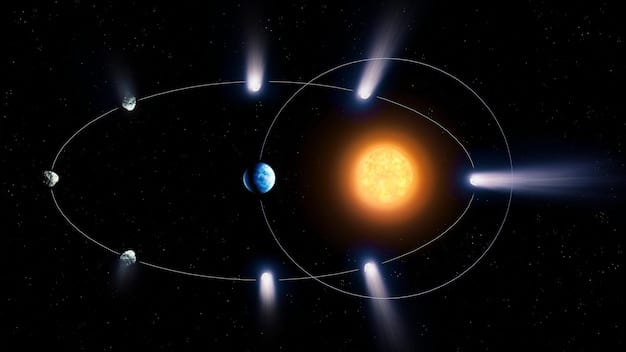New Exoplanet Discoveries: Are We Nearing Habitable Earth-like Worlds?

Recent exoplanet discoveries are increasingly focusing on finding habitable worlds similar to Earth, with ongoing missions and advanced technologies bringing us closer to answering whether we are alone in the universe.
The quest to find another Earth has intensified with recent new exoplanet discoveries. Are we on the verge of finding habitable worlds that mirror our own, and what are the latest advancements pushing us closer to this profound discovery?
The Allure of Exoplanet Exploration
The search for exoplanets—planets outside our solar system—captures the imagination because it addresses fundamental questions about life beyond Earth. The possibility of finding a habitable planet, one capable of supporting life as we know it, drives significant scientific interest and investment.
Exoplanet exploration is not just about finding new planets; it’s about understanding the conditions that make life possible and the potential for life to exist elsewhere in the universe. This field combines astronomy, biology, and geology, offering a multidisciplinary approach to answering one of humanity’s oldest questions.
Why Focus on Habitable Planets?
Habitable planets hold a special interest because they represent the most likely candidates for finding extraterrestrial life. These planets reside within the “Goldilocks zone” of their stars, where temperatures are just right for liquid water to exist on the surface—a key ingredient for life as we understand it.
The Technological Advancements Driving Discovery
Advancements in telescope technology, data analysis, and space missions have significantly enhanced our ability to detect and study exoplanets. From the Kepler Space Telescope to the James Webb Space Telescope, each mission builds upon the last, refining our techniques and expanding our reach.
- Improved telescope sensitivity allows for the detection of smaller, Earth-sized planets.
- Advanced spectroscopic techniques provide insights into the atmospheric composition of exoplanets.
- Sophisticated data analysis methods help to filter noise and identify potential exoplanet signals.
In summary, the allure of exoplanet exploration lies in its potential to uncover life beyond Earth and understand the conditions that make life possible. Technological advancements continue to push the boundaries of what we can discover, bringing us closer to answering the question of whether we are alone in the universe.
Recent Breakthroughs in Exoplanet Discoveries
Recent years have witnessed remarkable progress in the discovery of exoplanets. New missions and improved technologies have led to the identification of several promising candidates, each with unique characteristics.
These discoveries represent significant steps forward in our understanding of exoplanets and their potential habitability. By studying these planets in detail, scientists hope to identify the key factors that make a world suitable for life.

Key Exoplanets of Interest
Among the thousands of exoplanets discovered, a few stand out due to their potential habitability and unique characteristics. These planets are the focus of intensive study and observation.
The Role of Space Telescopes
Space-based telescopes like the James Webb Space Telescope (JWST) and the Transiting Exoplanet Survey Satellite (TESS) play a crucial role in exoplanet discovery and characterization. These telescopes offer unparalleled views of the cosmos, free from the atmospheric distortions that plague ground-based observatories.
- JWST provides detailed atmospheric analysis through infrared spectroscopy.
- TESS identifies potential exoplanets by detecting the slight dimming of a star as a planet passes in front of it.
- Future missions like the Nancy Grace Roman Space Telescope will further enhance our ability to detect and study exoplanets.
In conclusion, recent breakthroughs in exoplanet discoveries have revealed several promising candidates for habitability. Advanced space telescopes and improved technologies are instrumental in identifying and characterizing these planets, bringing us closer to understanding their potential to support life.
Assessing Habitability: Key Factors
Determining whether an exoplanet is habitable involves assessing a range of factors, from its distance from its star to the composition of its atmosphere. These factors provide clues about the planet’s potential to support liquid water and, potentially, life.
Understanding these key factors is essential for prioritizing exoplanets for further study and for developing strategies to search for signs of life. The more we learn about these factors, the better equipped we will be to answer the question of whether we are alone in the universe.
The Habitable Zone Explained
The habitable zone, also known as the Goldilocks zone, is the region around a star where temperatures are suitable for liquid water to exist on a planet’s surface. This zone is not fixed but varies depending on the size and temperature of the star.
Atmospheric Composition and Its Significance
The atmosphere of an exoplanet plays a crucial role in determining its habitability. The presence of certain gases can indicate the potential for life, while others can suggest hostile conditions. Spectroscopic analysis is used to identify the composition of exoplanet atmospheres.
- The presence of water vapor suggests the potential for liquid water on the surface.
- The detection of methane and oxygen could indicate biological activity.
- The absence of a protective ozone layer may expose the planet to harmful radiation.
In summary, assessing the habitability of an exoplanet involves evaluating several key factors, including its location within the habitable zone and the composition of its atmosphere. These factors provide valuable insights into the planet’s potential to support liquid water and, potentially, life.
Challenges in Detecting Earth-Like Exoplanets
Detecting Earth-like exoplanets is a formidable challenge due to their small size and faintness compared to their host stars. Overcoming these challenges requires innovative technologies and sophisticated data analysis techniques.
Addressing these challenges is crucial for advancing our search for habitable planets and for understanding the frequency of Earth-like worlds in the galaxy. The development of new technologies and techniques will continue to push the boundaries of what we can detect and study.
The Size and Distance Dilemma
Earth-sized exoplanets are incredibly small and distant, making them difficult to detect using current methods. The transit method, which detects exoplanets by observing the slight dimming of a star as a planet passes in front of it, becomes less effective with smaller planets.
Distinguishing Signals from Noise
The signals from exoplanets are often faint and can be easily obscured by noise from the star or the observing instruments. Sophisticated data analysis techniques are needed to filter out this noise and identify potential exoplanet signals.

- Advanced algorithms are used to remove instrumental artifacts and stellar variability.
- Statistical methods are employed to assess the significance of potential exoplanet signals.
- Machine learning techniques are being developed to identify subtle patterns in the data.
In conclusion, detecting Earth-like exoplanets presents significant challenges due to their small size and the need to distinguish faint signals from background noise. Overcoming these challenges requires advanced technologies and sophisticated data analysis techniques, which are constantly being refined and improved.
Future Missions and Technologies
The future of exoplanet exploration is bright, with several exciting missions and technologies on the horizon. These advancements promise to enhance our ability to detect and characterize exoplanets, bringing us closer to finding habitable worlds.
Investing in future missions and technologies is essential for advancing our understanding of exoplanets and for answering the fundamental question of whether we are alone in the universe. These advancements will pave the way for new discoveries and insights into the diversity of worlds beyond our solar system.
The Nancy Grace Roman Space Telescope
The Nancy Grace Roman Space Telescope, scheduled for launch in the late 2020s, will revolutionize exoplanet research. This telescope will use gravitational microlensing to detect exoplanets, a technique that is particularly sensitive to Earth-sized planets.
Advancements in Ground-Based Observatories
Ground-based observatories are also undergoing significant upgrades, with new telescopes that will provide enhanced capabilities for exoplanet detection and characterization. These telescopes will complement space-based missions, offering a comprehensive approach to exoplanet research.
- The Extremely Large Telescope (ELT) will be the largest optical telescope in the world, providing unprecedented views of the cosmos.
- The Thirty Meter Telescope (TMT) will offer high-resolution imaging and spectroscopic capabilities.
- These telescopes will enable detailed studies of exoplanet atmospheres and surfaces.
In summary, the future of exoplanet exploration is filled with promise, with new missions and technologies poised to transform our understanding of exoplanets. The Nancy Grace Roman Space Telescope and advancements in ground-based observatories will provide enhanced capabilities for detecting and characterizing exoplanets, bringing us closer to finding habitable worlds.
The Search for Biosignatures
The ultimate goal of exoplanet exploration is to find evidence of life beyond Earth. This involves searching for biosignatures—indicators of life—in the atmospheres of exoplanets. Identifying these biosignatures is a complex and challenging endeavor.
The search for biosignatures represents the culmination of decades of research and technological development. Success in this endeavor would have profound implications for our understanding of life in the universe and our place within it.
What Are Biosignatures?
Biosignatures are chemical compounds or conditions that suggest the presence of life. These can include gases like oxygen, methane, and ozone, as well as patterns in the light reflected from a planet’s surface that may indicate the presence of vegetation.
Challenges in Identifying Biosignatures
Identifying biosignatures is not straightforward. Many of the gases that could indicate life can also be produced by non-biological processes. Scientists must carefully consider the context in which these gases are found and rule out alternative explanations.
- Oxygen can be produced by the breakdown of water molecules in the atmosphere.
- Methane can be released by volcanic activity.
- The detection of multiple biosignatures can strengthen the case for life.
In conclusion, the search for biosignatures is a critical step in exoplanet exploration, representing the potential to find evidence of life beyond Earth. This involves identifying chemical compounds or conditions that suggest the presence of life, while carefully considering alternative explanations. Success in this endeavor would have profound implications for our understanding of the universe.
| Key Point | Brief Description |
|---|---|
| 🔭 Exoplanet Discoveries | Increased detection of potential habitable worlds. |
| 🌡️ Habitable Zone | Region around a star with potential for liquid water. |
| 🔬 Biosignatures | Indicators of life found in exoplanet atmospheres. |
| 🚀 Future Missions | New telescopes enhancing exoplanet detection capabilities. |
FAQ
▼
An exoplanet is a planet that orbits a star outside of our solar system. These planets vary greatly in size, composition, and distance from their stars, presenting a diverse range of possibilities for habitability.
▼
Scientists use several methods to detect exoplanets, including the transit method (observing dimming of a star) and radial velocity method (measuring a star’s wobble). These techniques help identify planets that would otherwise be invisible.
▼
A habitable planet generally possesses a suitable temperature range for liquid water, an atmosphere, and the right chemical elements. These conditions support biological processes and the potential for life.
▼
Biosignatures are indicators of life—such as specific gases or chemical compounds. They are crucial because their presence in an exoplanet’s atmosphere could indicate the existence of living organisms.
▼
Future missions, like the Nancy Grace Roman Space Telescope, will employ advanced technologies to enhance exoplanet detection. These missions aim to find and study more Earth-like planets, greatly improving our search.
Conclusion
The ongoing discoveries of new exoplanets are bringing us ever closer to potentially finding habitable worlds similar to Earth. With advancing technologies and dedicated missions, the possibility of answering the profound question of whether we are alone in the universe is becoming an increasingly tangible reality.





